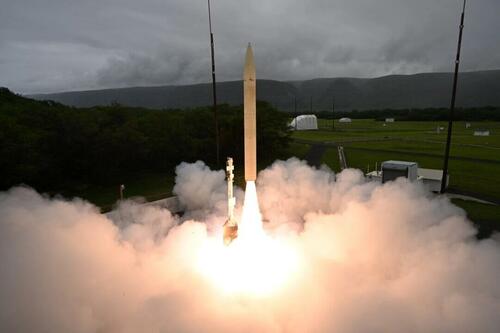
US Completes Hypersonic Missile Flight Test In Bid To Keep Up With China
Authored by Aldgra Fredly via The Epoch Times,
The U.S. Army and Navy have recently completed a flight test of a hypersonic missile as the United States seeks to keep pace with its geopolitical rivals—China and Russia—in developing hypersonic capabilities.

The military performed the flight test from the Pacific Missile Range Facility in Kauai, Hawaii, to gather data on the overall performance of the long-range hypersonic weapon (LRHW), the Pentagon said on June 28.
The LRHW is equipped with the Navy’s Conventional Prompt Strike (CPS) All-Up-Round missile—which consists of a two-stage solid rocket motor booster and a hypersonic glide body—and the Army’s canister.
CPS is a hypersonic missile development and test program that “provides longer range, shorter flight times, and high survivability against enemy defenses,” according to Lockheed Martin.
Lt. Gen. Robert Rasch Jr., director of the U.S. Army’s Rapid Capabilities and Critical Technologies Office, said that the missile development was intended to help the U.S. military “maintain superiority over any potential adversaries.”
The Pentagon did not elaborate on the data obtained from the flight test or provide additional details about the hypersonic missile.
The test comes about a month after the U.S. Army awarded Lockheed Martin a $756 million contract to supply the additional equipment and support for the nation’s ground-based hypersonic weapon system, the LRHW.
Under the contract, the aerospace and defense company will provide the U.S. Army with LRHW battery equipment, systems, and software engineering support, as well as logistics solutions.
Dark Eagle
A recent report by the Congressional Research Service stated that the U.S. Army’s LRHW, dubbed the Dark Eagle, can travel at more than 3,800 miles per hour and is capable of reaching “the top of the Earth’s atmosphere.”
The weapon system can maintain a position “just beyond the range of air and missile defense systems” until it is ready to strike, according to the report.
It provides the U.S. Army with a weapon system for strategic attacks to counter anti-access/area denial capabilities—weapons used to keep an enemy out of a certain area— suppress adversary long-range fire, and engage other important targets.
Lockheed Martin delivered the first LRHW battery to the U.S. military in 2021. The U.S. Army has been collaborating with the U.S. Navy to develop the weapon system, according to the report.
The United States has been testing its hypersonic missile capabilities amid growing concern that Russia and China have been more successful in developing such weapons.
Rick Fisher, a senior fellow at the International Assessment and Strategy Center, a security-focused think tank, said last year that the United States trails China in the development of hypersonic weapons.
“China has effectively taken the lead in the hypersonic weapons race due to the breadth and depth of its technology investments,” Mr. Fisher said.
“We are only seeing the beginning of their weapons developments in this field.”
The Pentagon, in its annual report to Congress last year, warned that China already “has the world’s leading hypersonic arsenal,” which includes the DF-17 medium-range ballistic missiles that can be armed with hypersonic glide vehicles (HGVs). An HGV, fitted to a ballistic missile, enables it to maneuver and glide at hypersonic speeds and alter trajectories after launch.
According to the report, the DF-17 HGV-armed medium-range ballistic missile system is “possibly intended to replace some older SRBM [short-range ballistic missile] units and is intended to strike foreign military bases and fleets in the Western Pacific, according to a PRC-based military expert.” PRC is the acronym for China’s official name, the People’s Republic of China.
Tyler Durden
Tue, 07/02/2024 – 21:40








![A gdyby tak rzucić wszystko i wyjechać do Maroka… [zdjęcia]](https://tarnow.ikc.pl/wp-content/uploads/2025/10/ucieczka-do-tangeru-fot.-Artur-Gawle0001.jpg)


